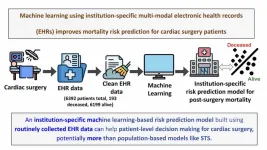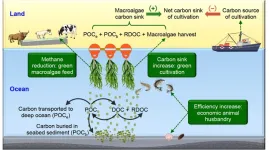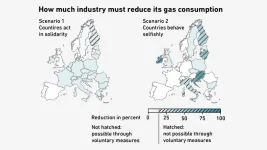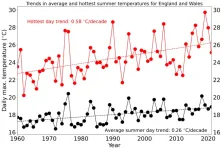(Press-News.org) Human-caused climate change made April’s record-breaking humid heatwave in Bangladesh, India, Laos and Thailand at least 30 times more likely, according to rapid attribution analysis by an international team of leading climate scientists as part of the World Weather Attribution group. The study also concludes that the high vulnerability in the region, which is one of the world’s heatwave hotpots, amplified the impacts.
In April, parts of south and southeast Asia experienced an intense heatwave, with record-breaking temperatures that passed 42ºC in Laos and 45°C in Thailand. The heat caused widespread hospitalisations, damaged roads, sparked fires and led to school closures. The number of deaths remains unknown.
Across the world, climate change has made heatwaves more common, longer and hotter. To quantify the effect of climate change on the Asian heatwave, scientists analysed weather data and computer model simulations to compare the climate as it is today, after about 1.2°C of global warming since the late 1800s, with the climate of the past, following peer-reviewed methods.
The analysis looked at the average maximum temperature and maximum values of a heat index for four consecutive days in April across two regions, one covering south and east India and Bangladesh, and a second one including all of Thailand and Laos. The heat index is a measure that combines temperature and humidity and reflects more accurately the impacts of heatwaves on the human body.
In both regions, the researchers found that climate change made the humid heatwave at least 30 times more likely, with temperatures at least 2°C hotter than they would have been without climate change. Until overall greenhouse gas emissions are halted, global temperatures will continue to increase and events like this will become more frequent and severe.
In Bangladesh and India, events like the recent humid heatwave used to occur less than once a century on average; they can now be expected around once in five years, and if temperature rise reaches 2°C - as will happen within around 30 years if emissions are not cut rapidly - events like this will occur, on average, at least once every two years.
In Laos and Thailand, the scientists found that an event like the recent record humid heatwave would have been nearly impossible without the influence of climate change, and it is still a very unusual event that can only be expected around once in 200 years, even with the influence of human-caused climate change. But if temperature rise reaches 2°C, it will become much more common, occurring about once in 20 years.
While high temperatures are the norm in south and southeast Asia, early heatwaves such as this one are particularly damaging. People who are most exposed to the sun and vulnerable populations are routinely the worst impacted. The current patchwork of heatwave solutions must be improved to account for inequalities and existing vulnerabilities, the scientists said, adding that heat action plans should be inclusive and comprehensive, and ensure access to basic services, such as water, electricity and health care.
The study was conducted by 22 researchers as part of the World Weather Attribution initiative, including scientists from universities and meteorological agencies in India, Thailand, Australia, Denmark, France, Germany, Kenya, the Netherlands, the UK, and the United States.
Quotes
Chandra Sekhar Bahinipati, Indian Institute of Technology Tirupati, India, said:
"Although we have recognized heatwaves as one of the deadliest disasters, particularly in countries like India, Bangladesh, and Thailand, there is a lack of knowledge with respect to who is vulnerable, loss and damage estimation, household coping mechanisms, and the most effective heat action plans. Except for the human casualties, other economic and non-economic loss and damage indicators are not documented. This creates a dearth in assessing the extent of risk, who is vulnerable, and also operationalizing any adaptation planning."
Friederike Otto, Senior Lecturer in Climate Science at the Grantham Institute for Climate Change and the Environment, said:
“We see again and again that climate change dramatically increases the frequency and intensity of heatwaves, one of the deadliest weather events there are. Still, heat action plans are only being introduced very slowly across the globe. They need to be an absolute priority adaptation action everywhere, but in particular in places where high humidity enhances the impacts of heatwaves.”
Emmanuel Raju, Director of Copenhagen Centre for Disaster Research at the University of Copenhagen, said:
“This is another disaster that highlights the need to reduce vulnerability and think deeper about the limits to adaptation. As it often happens, marginalised people are the worst affected. Many of them are still recovering from the pandemic, and from past heatwaves and cyclones, which leaves them trapped in a vicious cycle. It is fundamental to implement mitigation and adaptation strategies to avoid visible and invisible loss and damage”.
About this study
World Weather Attribution (WWA) is an international collaboration that analyses and communicates the possible influence of climate change on extreme weather events, such as storms, extreme rainfall, heatwaves, cold spells, and droughts. It is led by Dr Fredi Otto, Senior Lecturer in Climate Change at the Grantham Institute - Climate Change and the Environment at Imperial College London and Sjoukje Philip and Sarah Kew at KNMI.
Since WWA started in 2014, the group has developed methods to do extreme event attribution quickly but thoroughly. Read a detailed description of the methods and links to the peer-reviewed studies developing these methods.
Previous studies by WWA include research that found that climate change exacerbated floods in Nigeria and other parts of West Africa this year. WWA studies have also shown that this year’s drought in the Northern Hemisphere was made more likely by climate change and that it increased the rainfall that led to Pakistan’s deadly flooding, but that it was not the main driver in Madagascar’s 2021 food crisis.
Study authors:
Mariam Zachariah, Grantham Institute, Imperial College London, UK
Robert Vautard, Institut Pierre-Simon Laplace, CNRS, Sorbonne Université, Paris, France
Chaithra S T, Centre for Atmospheric Sciences, Indian Institute of Technology Delhi, India
Joyce J Kimutai, Grantham Institute, Imperial College London, UK
Arulalan T, India Meteorological Department, Ministry of Earth Sciences, Gov. of India, Centre for Atmospheric Sciences, Indian Institute of Technology Delhi, India
Krishna AchutaRao, Centre for Atmospheric Sciences, Indian Institute of Technology Delhi, India
Clair Barnes, Grantham Institute, Imperial College London, UK
Roop Singh, Red Cross Red Crescent Climate Centre, The Hague, the Netherlands
Maja Vahlberg, Red Cross Red Crescent Climate Centre, The Hague, the Netherlands
Julie Arrgihi, Red Cross Red Crescent Climate Centre, The Hague, the Netherlands; Global Disaster Preparedness Center, Washington DC, USA; University of Twente, The Netherlands
Emmanuel Raju, Department of Public Health, Global Health Section & Copenhagen Centre for Disaster
Upasna Sharma, School of Public Policy, Indian Institute of Technology Delhi, India
Anshu Ogra, School of Public Policy, Indian Institute of Technology Delhi, India
Chaya Vaddhanaphuti, Department of Geography, Chiang Mai University, Thailand
Chandra Sekhar Bahinipati, Department of Humanities and Social Sciences, Indian Institute of Technology Tirupati, India
Petra Tschakert, School of Media, Creative Arts and Social Inquiry, Curtin University, Perth, Australia
Ram Chandrasekaran, School of Media, Creative Arts and Social Inquiry, Curtin University, Perth, Australia
Carolina Pereira Marghidan, Red Cross Red Crescent Climate Centre, The Hague, the Netherlands; Faculty of Geo-Information Science and Earth Observation (ITC), University of Twente, Enschede, the Netherlands
Arpita Mondal, Civil Engineering Department, Indian Institute of Technology Bombay, India; IDP in Climate Studies, Indian Institute of Technology Bombay, India
Clemens Schwingshackl, Department of Geography, Ludwig-Maximilians-Universität München, Munich, Germany
Sjoukje Philip, Royal Netherlands Meteorological Institute (KNMI), De Bilt, The Netherlands
Friederike E L Otto, Grantham Institute, Imperial College London, UK END
Climate change made record Asia humid heatwave at least 30 times more likely: attribution study
High vulnerability to heat in the region worsened impacts of the heatwave
2023-05-17
ELSE PRESS RELEASES FROM THIS DATE:
Study finds link between deprived areas and number of children in care proceedings in England
2023-05-17
A strong link between the extent of deprivation of local authorities in England and their numbers of children going into the care system through the family courts has been uncovered by researchers at Lancaster University.
The study, available online and due to be published in July 2023 in the journal Children & Society, found that for every one unit increase in the standardized Office for National Statistics’ (ONS) English index of multiple area deprivation, the number of children in care proceedings in English family courts increased by around 70%.
The research team analysed data from the English Children and Family Court Advisory and Support Service ...
Call for papers: JMIR Dermatology special theme issue on teledermatology
2023-05-17
JMIR Dermatology—the official journal of the International Society of Teledermatology (ISTD)—and the journal’s guest editors welcome submissions to a special theme issue to coincide with the 10th ISTD World Congress held at the 23rd World Congress of Dermatology on July 4 to 7, 2023, in Singapore.
This theme issue will allow attendees of the ISTD World Congress to share their work with a wider audience by disseminating their work in a well-respected, peer-reviewed, open-access journal.
Teledermatology has been increasingly gaining recognition as a means of delivering dermatological ...
Researchers show that a machine learning model can improve mortality risk prediction for cardiac surgery patients
2023-05-17
A machine learning-based model that enables medical institutions to predict the mortality risk for individual cardiac surgery patients has been developed by a Mount Sinai research team, providing a significant performance advantage over current population-derived models.
The new data-driven algorithm, built on troves of electronic health records (EHR), is the first institution-specific model for assessing a cardiac patient’s risk prior to surgery, thus allowing health care providers to pursue the best course of action for that individual. The team’s work was described in a study published in The Journal of Thoracic and Cardiovascular Surgery ...
Machine learning lets researchers see beyond the spectrum
2023-05-17
Tokyo, Japan – Organic chemistry, the study of carbon-based molecules, underlies not only the science of living organisms, but is critical for many current and future technologies, such as organic light-emitting diode (OLED) displays. Understanding the electronic structure of a material’s molecules is key to predicting the material’s chemical properties.
In a study recently published by researchers at the Institute of Industrial Science, The University of Tokyo, a machine-learning algorithm was developed to predict the density ...
The predicted average annual net carbon sink of Gracilaria cultivation in China from 2021 to 2030 may double that of the last ten years
2023-05-17
A marine research team led by Professor YAN Qingyun has proposed a method to assess the net carbon sink of marine macroalgae (Gracilaria) cultivation. Then, they calculated the net carbon sink of Gracilaria cultivation in China based on the yield of annual cultivated Gracilaria in the last ten years. Also, the net carbon sink trend of Gracilaria cultivation in the next ten years was predicted by the autoregressive integrated moving average model (ARIMA). Finally, they explored the potential carbon sink increase and methane reduction related to Gracilaria cultivation in China through a scenario analysis.
Their results suggested that the net carbon sink ...
Countries would be well advised to assist each other with regard to gas
2023-05-17
Prior to Putin’s invasion of Ukraine, Europe sourced a great deal of natural gas from Russia. But as a result of EU sanctions on Russia, this supply is no longer there. European countries have scrambled to find and secure new suppliers. But if both the war and these sanctions last into next winter, gas will remain in short supply – especially if next winter is a cold one and people need a lot of gas for heating. There is a distinct possibility that a shortage of gas will mean homes go unheated and will force industry to halt production. As a result, some countries might ...
ETRI commercializes a light source device capable of transmitting 25Gbps 30km
2023-05-17
Korean researchers and an SME have successfully commercialized a light source1) capable of transmitting 25 billion bits per second over long distances for the first time in Korea.
1) Light source: An element that converts electrical signals into optical signals and is manufactured by a compound semiconductor process
Electronics and Telecommunications Research Institute(ETRI) announced that it has succeeded in commercializing an electro-absorption modulator-integrated laser(EML)2) capable of transmitting data over 30 km at a speed of 25 Gbps with ELDIS Co., Ltd., a III-V semiconductor laser ...
Interventions with drug-coated balloons – a PCR Statement
2023-05-17
Paris, France, 17 May 2023. The field of coronary drug-coated balloon (DCB) angioplasty looks set to assume growing importance in the years to come and the potential for increased use of these devices in clinical practice is considerable.
DCB catheters became available for coronary use in Europe more than 14 years ago and have become widely used in clinical practice around the world since then. In recent years there has been renewed interest in this therapy linked to the development of novel devices coated with drugs from the limus family and a wider experience in the treatment of de novo lesions. As of today, for coronary use, there are no less ...
Extremely hot days are warming twice as fast as average summer days in North-West Europe
2023-05-17
New study analysed data on near-surface air temperatures recorded for North-West Europe over the past 60 years.
The findings show that the maximum temperature of the hottest days is increasing at twice the rate of the maximum temperature of average summer days.
The results highlight the need for urgent action by policy makers to adapt essential infrastructure to the impacts of climate change.
New research led by the University of Oxford has found that climate change is causing the hottest days in North-West Europe to warm at double the rate of average ...
Coronary bioresorbable scaffolds nearly as safe and effective as conventional metal stents for heart disease patients
2023-05-17
First-generation bioresorbable vascular scaffolds (BVS) may be just as effective as drug-eluting metallic stents, which are currently the standard treatment for heart disease patients undergoing percutaneous coronary intervention (PCI).
These are significant findings from a global clinical trial led by a researcher from the Icahn School of Medicine at Mount Sinai. The work could lead to advancements and improvements in new BVS technology and future clinical use among interventional cardiologists across the ...
LAST 30 PRESS RELEASES:
Injectable breast ‘implant’ offers alternative to traditional surgeries
Neuroscientists devise formulas to measure multilingualism
New prostate cancer trial seeks to reduce toxicity without sacrificing efficacy
Geometry shapes life
A CRISPR screen reveals many previously unrecognized genes required for brain development and a new neurodevelopmental disorder
Hot flush treatment has anti-breast cancer activity, study finds
Securing AI systems against growing cybersecurity threats
Longest observation of an active solar region
Why nail-biting, procrastination and other self-sabotaging behaviors are rooted in survival instincts
Regional variations in mechanical properties of porcine leptomeninges
Artificial empathy in therapy and healthcare: advancements in interpersonal interaction technologies
Why some brains switch gears more efficiently than others
UVA’s Jundong Li wins ICDM’S 2025 Tao Li Award for data mining, machine learning
UVA’s low-power, high-performance computer power player Mircea Stan earns National Academy of Inventors fellowship
Not playing by the rules: USU researcher explores filamentous algae dynamics in rivers
Do our body clocks influence our risk of dementia?
Anthropologists offer new evidence of bipedalism in long-debated fossil discovery
Safer receipt paper from wood
Dosage-sensitive genes suggest no whole-genome duplications in ancestral angiosperm
First ancient human herpesvirus genomes document their deep history with humans
Why Some Bacteria Survive Antibiotics and How to Stop Them - New study reveals that bacteria can survive antibiotic treatment through two fundamentally different “shutdown modes”
UCLA study links scar healing to dangerous placenta condition
CHANGE-seq-BE finds off-target changes in the genome from base editors
The Journal of Nuclear Medicine Ahead-of-Print Tip Sheet: January 2, 2026
Delayed or absent first dose of measles, mumps, and rubella vaccination
Trends in US preterm birth rates by household income and race and ethnicity
Study identifies potential biomarker linked to progression and brain inflammation in multiple sclerosis
Many mothers in Norway do not show up for postnatal check-ups
Researchers want to find out why quick clay is so unstable
Superradiant spins show teamwork at the quantum scale
[Press-News.org] Climate change made record Asia humid heatwave at least 30 times more likely: attribution studyHigh vulnerability to heat in the region worsened impacts of the heatwave







